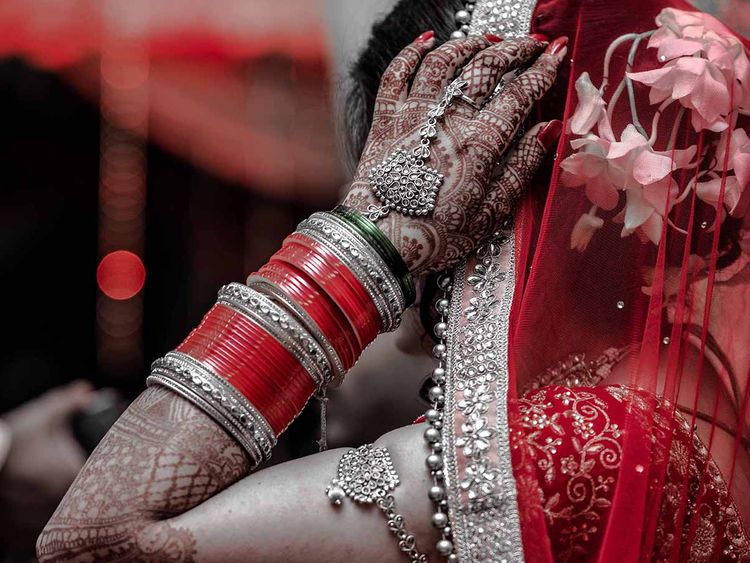
Women forced to take several husbands in Baghpat, UP. (Representational image)
Image Credit: Stock imageWomen in this part of India are being forced to marry multiple husbands
Girls are disappearing from some communities, some are bought as 'slaves' by the men
Dubai: Women are being forced to take several husbands at once amid ‘wife shortage’ in the Baghpat district in the Indian state of Uttar Pradesh.
An August 2019 story by the Telegraph shares the account of 17-year-old Majida who was married off to a lorry driver living in the north Indian state. Barely a month into her marriage she was expected to act as a wife for two of her husband’s brothers. When she refused, she was raped and assaulted.
“They come on different days, they have their turns, they have their days,” the young woman told the Telegraph.
This trend of forced polyandry and trade in brides is being fuelled by the growing gender imbalance caused mainly by parents aborting female babies.
And, the Baghpat district is considered to be at the core of India’s gender imbalance crisis that the United Nations warned in 2014 had reached “emergency proportions”.
According to the 2011 Indian government census showed that there were only 856 females to 1,000 males in the district.
Dr Neelam Singh – who runs Vatsalya, an NGO combating female foeticide in Uttar Pradesh – warns the gap has widened significantly since those figures were published. “When the 2021 census is published we believe [it will show] sex ratios have declined further and fast.”
Missing female children
Women's rights campaigner Devendra Dhama told the Daily Telegraph: “In our region, especially in middle and lower-class families, if you go to houses you’ll notice that you don’t see any girls there.”
Brides are bought from poverty stricken families.
Officially they can be married to one brother but are expected to act as a wife to several others, sometimes to brothers and cousins within the same family.
What is female infanticide?
Female infanticide is the deliberate killing of girl babies. It is also described as gender-selective killing or gendercide. It is perhaps one of the worst forms of violence against women where a woman is denied her most basic and fundamental right or “the right to life”.
A 2011 study conducted by India’s Central Statistics Office under the Ministry of Statistics and Programme said that nearly three million girls went missing in India due to female infanticide. It’s estimated that 10 million female births (500,000 every year) have been aborted in India in the last 20 years.
The Population Research Institute found that about 15.8 million girls have been killed in the womb through sex-selective abortions in India since 1990.
Sex-selective abortions are illegal, but the law is ignored.
Authorities in Uttarkashi, Uttarakhand state, raised the alarm in July after data showed none of children born in 132 villages were girls.
Girls: An ‘economic burden’ for many in India
Many parents in India show a preference for sons over daughters.
In September last year, a global study on female infanticide by Asian Centre for Human Rights, a Delhi-based NGO (non-governmental organisation) dedicated to the protection of human rights, revealed that this preference is a major reason for female infanticide in many countries around the world. Dowry system in South Asia, which makes daughters “an unaffordable economic burden”, also contributes to female infanticide.
Boys are favoured over girls because they bring in money for their families. Girls can be a financial liability.
This is because when women marry their families have to provide for their in-laws. But when the son marries, the family benefits, especially in the form of dowries, even though the practice is illegal in India.
Gender ratio
The United Nations Population Fund (UNFPA) notes that biologically, the normal sex ratio at birth (SRB) in a country should vary from 102 to 106 males per 100 females. India’s stands at 120 males/100 girls and that rate is among the highest in the world.
How does that matter? The Asian Centre for Human Rights in its 2016 report, titled Female Infanticide Worldwide noted: “The growing surplus of men has dire consequences for the human race, among others for causing trafficking of girls/women in the areas having shortage of women and these trafficked girls/women facing violence and discrimination.”
Government schemes
The Indian government and child rights activists are fighting this issue persistently.
The national Pre-Conception and Pre-Natal Diagnostics Techniques (PNDT) Act of 1994, implemented in 1996, banned sex-selective abortions in the Indian states.
Financial benefit schemes such as the Balika Samridhi Yojana and Dhanalakshmi were introduced to encourage families to have the girl child. The Hindu Succession (Amendment) Act of 2005 also made it possible for daughters to inherit their father’s property.
In January 2015, Indian Prime Minister Narendra Modi launched the “Beti Bachao Beti Padhao” (Save the girl child, educate girl child) campaign and said: “Our mental illness is responsible for this poor sex ratio. We give a lot of importance to boys. Many women also do this. But for how long will we look at girls as ‘paraya dhan’ (someone else’s property)? For every 1,000 boys born, 1,000 girls should also be born. I want to ask you if girls are not born, where will you get your daughters-in-law from?”
However, clearly, these schemes and laws are not enough.
















No comments:
Post a Comment